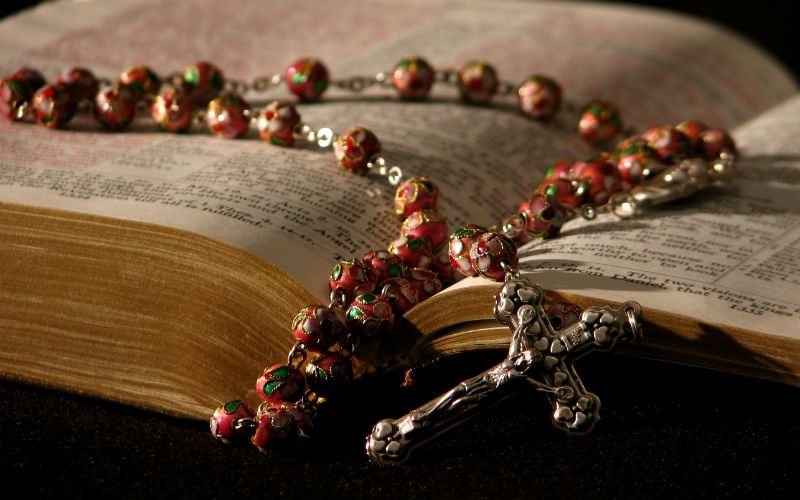Dennis Di Mauro was a Lutheran man with a Catholic wife, and he was saddened that Protestants had rejected the rosary.
“I have read some excellent articles on how the rosary is completely ecumenical in spirit and fully seeks to unite all Christians in prayer,” he writes, explaining he had first been introduced to the centuries-old Marian devotion in a prayer group he and his wife were a part of, “and this is undoubtedly true.” But he also knew that most Protestants would never embrace it.
[See also: The ORIGINAL Rosary Dates Back All the Way to the Holy Family]
[See also: How This Protestant Came to Love the Rosary]
So, in 1999, with lots of prayer, he created an “ecumenical variation on the rosary,” which he named the “Ecumenical Miracle Rosary.”
Di Mauro is clear he is not trying to replace the rosary: “The Ecumenical Miracle Rosary is in no way meant to be a replacement for the traditional rosary,” he explains, “but a complement to it.” Hopefully, it can be a way from Protestants to be introduced to the kind of prayer the rosary is.
The devotion uses traditional rosary beads and has basically the same structure. But there are some key differences.
First off, instead of meditating on the traditional “mysteries,” you meditate on “miracles” of Christ in the Bible. Second, the Nicene Creed replaces the Apostles’ Creed. Third, the “Hail Mary” and “Glory Be” prayers are dropped from the decades and replaced with prayers inspired by the Greatest Commandment and the Great Commission. Finally, rather than ending with “Hail, Holy Queen,” the devotion ends with the ancient Jesus Prayer.
Di Mauro hopes that the devotion can strengthen ecumenical efforts: “My goal is to share the rosary with Christians of other traditions in order to achieve greater unity between all Christian denominations. It is also hoped that the rosary could be used in ecumenical group settings such as prayer vigils, ecumenical Christmas and Easter celebrations, etc.”
“It is a form of spiritual ecumenism.”
Here’s how it works:
Introduction
1) On the Crucifix, recite the Nicene Creed
2) On the first large bead, say the Lord’s Prayer
3) On the next three small beads, recite this paraphrase of the Greatest Commandment:
Sweet Jesus, I love you with all my heart and all my soul, Help me to serve my family, and everyone else I meet today
4) On the next large bead, recite this paraphrase of the Great Commission:
Oh my lord, I know that you are always with me, help me to obey your commandments, And lead me to share my faith with others, so that they may know you and love you.
The 5 Decades
5) At the beginning of each decade, recall one of the miracles (see below) and recite the Lord’s Prayer
6) On each of the 10 small beads, recite the paraphrase of the Greatest Commandment:
Sweet Jesus, I love you with all my heart and all my soul, Help me to serve my family, and everyone else I meet today
7) Conclude the decade by reciting the paraphrase of the Great Commission:
Oh my lord, I know that you are always with me, help me to obey your commandments, And lead me to share my faith with others, so that they may know you and love you.
Conclusion
8) On the central medal, pray the Jesus Prayer:
Lord Jesus Christ, Son of God; have mercy upon me, a sinner.
And you’re done!
And here are the Scriptural miracles on which you meditate:
1) Miraculous Healings
- Jesus Heals the Centurion’s Servant (Luke 7.1-10 and Matthew 8.5-13)
- A Woman Touches Jesus’ Garments (Matthew 9.20-22, Mark 5.25-34, and Luke 8.43-48)
- Jesus Heals the Blind Man with Mud (Mark 8.22-26)
- Jesus Raises Lazarus from the Dead (John 11.17-44)
- Jesus Heals Ten Men with Leprosy (Luke 17.11-19)
2) Miraculous Acts
- Jesus Turns Water into Wine (John 2.1-11)
- Jesus Calms the Storm (Matthew 8.18, 23-27, Mark 4.35-41, and Luke 8.22-25)
- Jesus Feeds the Five Thousand (Matthew 14.15-21, Mark 6.35-44, Luke 9.12-17, and John 6.4-13)
- Jesus Walks on Water (Matthew 14.24-33, Mark 6.47-52, and John 6.16-21)
- The Withered Fig Tree (Matthew 21.19-22 and Mark 11.19-25)
3) Miraculous Appearances
- Jesus Becomes Incarnate by the Holy Spirit from the Virgin Mary (Annunciation) (Luke 1.26-56)
- Transfiguration (Matthew 17.1-9, Mark 9.2-10, and Luke 9.28-36)
- Jesus Appears to Mary Magdalene (Mark 16.9-11 and John 20.11-18)
- Jesus Appears to Doubting Thomas (John 20.26-31)
- Jesus Appears to Paul (Acts 9.1-19)
What do you think of this devotion? Do you think it could help ecumenism? Let us know in the comments!
[See also: So Beautiful! Meditate to the Full Rosary Chanted in Latin]
[See also: 6 Lesser-Known Depictions of the Blessed Virgin Mary]

